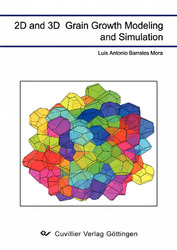| Fachbereiche | |
|---|---|
| Buchreihen (96) |
1378
|
| Nachhaltigkeit |
3
|
| Gesundheitswesen |
1
|
| Geisteswissenschaften |
2364
|
| Naturwissenschaften |
5406
|
| Mathematik | 229 |
| Informatik | 319 |
| Physik | 980 |
| Chemie | 1363 |
| Geowissenschaften | 131 |
| Humanmedizin | 243 |
| Zahn-, Mund- und Kieferheilkunde | 10 |
| Veterinärmedizin | 108 |
| Pharmazie | 147 |
| Biologie | 835 |
| Biochemie, Molekularbiologie, Gentechnologie | 121 |
| Biophysik | 25 |
| Ernährungs- und Haushaltswissenschaften | 45 |
| Land- und Agrarwissenschaften | 1004 |
| Forstwissenschaften | 201 |
| Gartenbauwissenschaft | 20 |
| Umweltforschung, Ökologie und Landespflege | 148 |
| Ingenieurwissenschaften |
1793
|
| Allgemein |
98
|
|
Leitlinien Unfallchirurgie
5. Auflage bestellen |
|
Erweiterte Suche
2D and 3D Grain Growth Modeling and Simulation
Luis Antonio Barraales Mora (Autor)Vorschau
Inhaltsverzeichnis, Datei (42 KB)
Leseprobe, Datei (230 KB)
Grain growth is the result of the collective migration of the grain boundaries of a polycrystal. Since grain boundaries are very complex elements, grain growth is complex as well. The mathematical description of the grain boundary requires four parameters in the two-dimensional case and eight parameters in the threedimensional one. The evolution of the microstructure in the course of grain growth is determined by the grain boundary mobility and energy; both properties depend on all the parameters for the definition of the grain boundary. Since triple lines, quadruple points and chemical composition play an important role, grain boundary becomes even more complex.
The modeling of the grain growth requires the consideration of all the factors that affect grain growth. In the present dissertation, a Vertex Model for the simulation of two- and three-dimensional grain growth is implemented. The two-dimensional model was corroborated with classic basic theories on grain growth. Simulation on normal grain growth showed scaling behavior und a deviation of less than 1% when compared with the von Neumann-Mullins relationship. Furthermore, the model validated the theory on the finite mobility of the triple junctions from Gottstein and Shvindlerman and with this the model showed its applicability for the simulation of more complex granular aggregates with a finite triple junction mobility. The model also allows the use of experimental data. For instance, it was utilized for the reproduction of an experimental setting of magnetic influenced grain growth in pure titanium samples. The results of the simulation demonstrated that a magnetic field can determined the texture and grain growth kinetics of magnetic anisotropic metals. Simulation can also help to understand unexpected experimental results. For example, it was explained by means of molecular static and vertex model simulation the faceting of certain grain boundaries in aluminum. For this purpose, the grain boundary energy was obtained from molecular-static simulation and subsequently used in Vertex simulation. The results showed that the faceting of the grain boundaries can be attributed to the anisotropy of the grain boundary energy with the inclination angle.
In turn, the 3D model was utilized to study the effect of the boundary junctions on three-dimensional grain growth. For this purpose a special configuration that allows the steady-state motion of the grain boundaries was used. The simulation results showed a very good agreement with the theoretical expectations and demonstrated that the finite mobility of the quadruple junctions can drag grain boundary migration. However, it was also found that triple lines drag more effectively grain growth.
| ISBN-13 (Printausgabe) | 3867276846 |
| ISBN-13 (Printausgabe) | 9783867276849 |
| ISBN-13 (E-Book) | 9783736926844 |
| Sprache | Englisch |
| Seitenanzahl | 148 |
| Auflage | 1 Aufl. |
| Band | 0 |
| Erscheinungsort | Göttingen |
| Promotionsort | Aachen |
| Erscheinungsdatum | 13.08.2008 |
| Allgemeine Einordnung | Dissertation |
| Fachbereiche |
Mathematik
Physik Bergbau- und Hüttenwesen |








